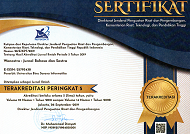An Analysis of Figurative Language in Maroon 5 – Nobody’s Love Song Lyrics
Abstract
Beautiful words have special meanings and involve expressing ideas in song lyrics through figurative language. This study discussed an analysis of the figurative language in the Maroon 5 song’s lyrics. This study emphasizes the use of figurative language and meaning in the lyrics of the song "Nobody's Love" by Maroon 5. Furthermore, the data source was taken from the lyrics of the Maroon 5 song lyrics. This research employed the descriptive qualitative model. In the analysis, the procedure began by reading the lyrics. Second, the researchers sought to identify words, phrases, and phrases that involved figurative language and catch each figurative language's context. Thirdly, the researchers took some notes about figurative language. Finally, the researchers classified and re-checked the details and analyzed them. The next step was the discussion of each category's results. The last step was drawing conclusions based on the report. The data showed five types of figurative language found in the lyrics of this song: Personification 20%, Hyperbole 30%, Irony 20%, Simile 20%, and Repetition 20%.
Full Text:
PDFReferences
Abbas, A. H. (2019). Super-hyperbolic man: Hyperbole as an ideological discourse strategy in Trump’s speeches. International Journal for the Semiotics of Law, 32(1), 1–18. https://doi.org/10.1007/s11196-019-09621-8
Ali, A. H., & Hamdi, H. Q. (2019). A pragmatic study of irony in some British and Iraqi TV comic shows. Journal of Language Studies, 1(4), 28–48. https://doi.org/10.25130/lang.v1i4.43
Arditami, P. R. (2017). An analysis of figurative language found in Katy Perry’s song entitled “firework.” Lingua Scientia, 24(2), 45–58.
Azwardi, S. (2016). Analysis of figurative language used in some Coldplay’s song lyrics. Ilmu pendidikan: Jurnal kajian teori dan praktik kependidikan, 45(1), 1–13.
Burgers, C., Konijn, E. A., & Steen, G. J. (2016). Figurative framing: Shaping public discourse through metaphor, hyperbole, and irony. Communication Theory, 26(4), 410–430.
https://doi.org/10.1111/comt.12096
Defisyani, W., Hamzah, & Fitrawati. (2016). The use of figurative language found in product advertisements for different genders. E-Journal of English Language and Literature, 7(1), 253–265.
Dewi, E. N. F., Hidayat, D. N., & Alek. (2020). Investigating figurative language in “Lose You to Love Me” song lyric. Loquen: English Studies Journal, 13(1), 6–16. https://doi.org/10.32678/loquen.v13i1.2548
Fitria, T. N. (2018). Figurative language used in one direction’s album entitled up all night. ELITE Journal, 5(1), 69–79.
George, M. W. (2008). The elements of library research: What every student needs to know. Princeton University Press. https://doi.org/10.1515/9781400830411
Green, M. (2018). Irony as expression (of a sense of the absurd). The Baltic International Yearbook of Cognition, Logic and Communication, 12(1), 1–24. https://doi.org/10.4148/1944-3676.1116
Harya, T. D. (2016). An analysis of figurative languages used in Coelhos’s novel entitled “alchemist.” Premise Journal, 5(2), 45–63. https://doi.org/10.24127/pj.v5i2.815
Hee, C. Van, Levefer, E., & Hoste, V. (2018). Exploring the fine-grained analysis and automatic detection of irony on Twitter. Language Resources and Evaluation, 52(1), 707–731.
https://doi.org/10.1007/s10579-018-9414-2
Hidayati, N. (2017). Figurative language in Kakong community : A study in Lombok island. Journal of English Education, 2(1), 74–82.
Ibrahim, I., Akib, M., & Hasyim, R. (2019). The analysis of figurative language in “endless love” song lyric. 8(2), 119–130. https://doi.org/10.33506/li.v8i2.464
Kalandadze, T., Norbury, C., Nærland, T., & Næss, K. A. B. (2018). Figurative language comprehension in individuals with autism spectrum disorder: A meta-analytic review. Autism, 22(2), 99–117. https://doi.org/10.1177/1362361316668652
Keraf, G. (2009). Diksi dan gaya bahasa. PT Gramedia Pustaka Utama.
Ko, H.-C. (2018). The sustainability of teaching personification in language education: A qualitative analysis using Kwang-Chung Yu’s free verse. Sustainability, 10(1), 1–23. https://doi.org/10.3390/su10103517
Liontas, J. I. (2018). Exploring figurative language across the curriculum. The TESOL Encyclopedia of English Language Teaching, 1–9. https://doi.org/10.1002/9781118784235.eelt0755
Nur, M. R. O., & Miranti, R. R. (2018). The analysis of figurative language used in ‘still I rise’ poem by Maya Angelou. International Summit on Science Technology and Humanity, 19–29.
Padillah, E. N., Firmawan, H., & Purwaningsih, E. (2016). Simile, hyperbole, personification and metaphor used in Gayle Forman’s if i stay. 4(1), 69–78.
Ratna, A. P. (2017). An analysis of figurative language found in Katy Perry’s song entitled “firework.” Lingua Scientia, 24(2), 45–58. https://doi.org/10.23887/ls.v24i2.18799
Setiawati, W., & Maryani. (2018). An analysis of figurative language in Taylor Swift’s song lyrics. PROJECT (Professional Journal of English Education), 1(3), 261–268. https://doi.org/10.22460/project.v1i3.p261-268
Siallagan, S. R., Manurung, S., & Sinaga, J. B. (2017). Analysis of figurative language and imagery in Taylor Swift’s songs. ANGLO-SAXON: Jurnal Ilmiah Program Studi Pendidikan Bahasa Inggris, 8(1), 55–67. https://doi.org/10.33373/anglo.v8i1.984
Suka, G., & Jeremia, J. (2019). A description of figurative language found in selected lyrics of One Direction song. Universitas Sumatera Utara.
Tairako, T. (2018). Reification-thingification and alienation: Basic concepts of Marx ʼ s critique of political economy and practical materialsm. Hitotsubashi Journal of Social Studies, 49(1), 1–28.
Tarigan, H. G. (2013). Pengajaran gaya bahasa. CV Angkasa.
Wood, H. (2017). The politics of hyperbole on Geordie Shore: Class, gender, youth and excess. European Journal of Cultural Studies, 20(1), 39–55. https://doi.org/10.1177/1367549416640552
Yusuf, F., & Amelia, A. R. (2018). Metaphor expression in fall for you song lyrics. ELITE Journal, 5(1), 35–45. https://doi.org/10.24252/elite.v5i1a4
DOI: https://doi.org/10.31294/w.v13i1.9744
Copyright (c) 2021 Farhan Muhammad, Didin Nuruddin Hidayat, Alek Alek

This work is licensed under a Creative Commons Attribution-ShareAlike 4.0 International License.
Index by:
Published by Department of Research and Community Service (LPPM) Universitas Bina Sarana Informatika by supported Relawan Jurnal Indonesia
Jl. Kramat Raya No.98, Kwitang, Kec. Senen, Jakarta Pusat, DKI Jakarta 10450

This work is licensed under a Creative Commons Attribution-ShareAlike 4.0 International License






